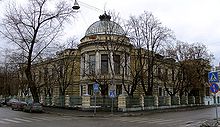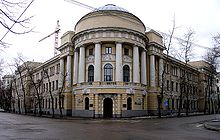
Moscow State University (MSU), officially M. V. Lomonosov Moscow State University, is a public research university in Moscow, Russia. The university includes 15 research institutes, 43 faculties, more than 300 departments, and six branches. Alumni of the university include past leaders of the Soviet Union and other governments. As of 2019, 13 Nobel laureates, six Fields Medal winners, and one Turing Award winner were affiliated with the university.

Church of St. John the Warrior on Yakimanka Street is a Russian Orthodox church in Yakimanka District of Moscow erected in 1704-1717, during the reign of Peter the Great. It is attributed to architect Ivan Zarudny. The church address is 46, Bolshaya Yakimanka.

Church of Saint Nicholas in Khamovniki is a late 17th-century parish church of a former weavers sloboda in Khamovniki District of Moscow.

Khamovniki District is a district of Central Administrative Okrug of the federal city of Moscow, Russia. Population: 102,730 (2010 Census); 97,110 (2002 Census).
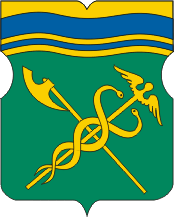
Zamoskvorechye District is a district of the Central Administrative Okrug of the federal city of Moscow, Russia. It has a population of 55,612 (2010 Census); 50,590 (2002 Census).

Tverskoy District is a district of Central Administrative Okrug of the federal city of Moscow, Russia. Population: 75,378 (2010 Census); 75,955 (2002 Census).
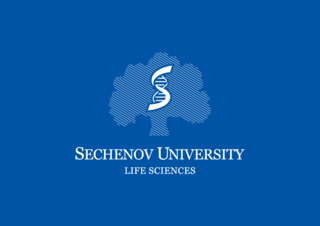
First Moscow State Medical University ; Russian: Первый Московский государственный медицинский университет имени И. М. Сеченова) is the oldest medical university in Russia, located in Moscow.

The Russian Revival style comprises a number of different movements within Russian architecture that arose in the second quarter of the 19th century and was an eclectic melding of Byzantine elements and pre-Petrine architecture.

Matvey Fyodorovich Kazakov was a Russian Neoclassical architect. Kazakov was one of the most influential Muscovite architects during the reign of Catherine II, completing numerous private residences, two royal palaces, two hospitals, Moscow University, and the Kremlin Senate. Most of his works were destroyed by the Fire of 1812; they were later rebuilt with various degrees of alteration.

Yakimanka District is a district of Central Administrative Okrug of the federal city of Moscow, Russia. Population: 26,578 (2010 Census); 22,822 (2002 Census).

Dorogomilovo District is a district of Western Administrative Okrug of the federal city of Moscow, Russia. The area of the district is 7.93 square kilometres (3.06 sq mi). Population: 67,720 (2010 Census); 59,732 (2002 Census). Postal codes: 113000 to 119000.

Alexander Ustinovich Zelenko, was a Russian and Soviet architect and educator, a pioneer in settlement movement and vocational education. Originally a practitioner of provincial Art Nouveau in Samara and Moscow, he later joined the camp of rationalists and focused on perfecting school and museum designs.

Fyodor Osipovich Schechtel was a Russian architect, graphic artist and stage designer, the most influential and prolific master of Russian Art Nouveau and late Russian Revival architecture.
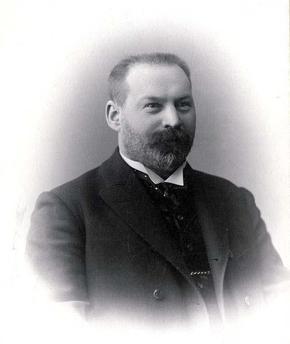
Lev Nikolayevich Kekushev was a Russian architect, notable for his Art Nouveau buildings in Moscow, built in the 1890s and early 1900s in the original, Franco-Belgian variety of this style. Kekushev's buildings are notable for his skillful use of metal ornaments and his signature with a lion (Lev) ornament or sculpture.
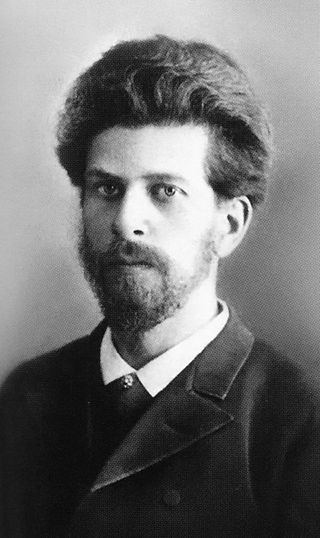
Roman Ivanovich Klein, born Robert Julius Klein was a Russian architect and educator, best known for his Neoclassical Pushkin Museum in Moscow. Klein, an eclectic, was one of the most prolific architects of his period, second only to Fyodor Schechtel. In the 1880s-1890s, he practiced Russian Revival and Neo-Gothic exteriors; in the 1900s, his knowledge of Roman and Byzantine classical architecture allowed him to integrate into the Neoclassical revival trend of that period.

Ivan Pavlovich Mashkov was a Russian architect and preservationist, notable for surveying and restoration of Dormition Cathedral of Moscow Kremlin, Novodevichy Convent and other medieval buildings. His best known extant building is Sokol (Falcon) luxury Art Nouveau apartment building in Kuznetsky Most Street, Moscow. A prolific architect, Mashkov built mostly eclectic buildings with Russian Revival features.

Illarion Aleksandrovich Ivanov-Schitz was a Russian architect, notable for developing a unique personal style, blending the Vienna Secession school of Otto Wagner with Greek Revival features. His career peaked in 1902-1912 with several Moscow buildings including the Morozov Hospital, the Merchant Club, Moscow Savings Bank, and the public buildings in Miusskaya Square. He was one of the few architects born in the 1860s who integrated into the Soviet establishment, earning the Order of Lenin for various resort projects and for redesigning the interiors of the Grand Kremlin Palace in the 1930s.

The Embassy of Vietnam in Moscow is the diplomatic mission of the Socialist Republic of Vietnam to the Russian Federation. The chancery is located at 13 Bolshaya Pirogovskaya Street in the Khamovniki District of Moscow.

The Arseny Morozov House is a historic building located at 16 Vozdvizhenka Street, Moscow. It was designed by Viktor Mazyrin for his friend Arseny Morozov. The pair had toured around Portugal and been impressed by the Pena Palace in Sintra. An eclectic building with Neo-Manueline architecture, the Morozov House was constructed on the land presented to Arseny by his mother Varvara. Mazyrin built the house between 1895 and 1899.

Savva Vasilyevich Morozov was an eighteenth-century Russian entrepreneur, who founded the Morozov dynasty.




